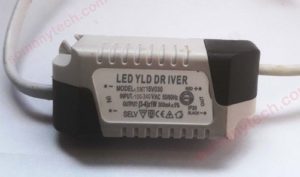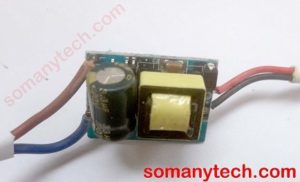LED driver detail working- How to choose the right one?
An LED driver is an electronic device that regulates the output voltage required to power an LED or LED array. The LED driver is also known as LED power supply. They provide LEDs with the specific voltage two functions so as to perform with full efficiency.
LEDs are well known for low power consumption along with long life-span.
Below is the explanation to the need of an LED driver, what actually LED driver do and what is inside an LED driver.
What is the need of an LED driver?
The operation of all LED light sources requires a driver. Typically, an individual LED light functions within a voltage range of 1.2 to 2.7 volts, and in some cases up to three volts, using direct current (DC) power. However, the typical domestic power supply is alternating current (AC) in nature, with a voltage of 120 or 230 volts, depending on the country. As a result, it is impossible to directly power an LED with an AC power source.

LED bulbs, found in homes, consist of arrays of LEDs connected in series or parallel to each other. These arrays require a standard DC voltage, typically in the range of 5 to 24 volts. The household power supply, on the other hand, provides 120 or 230 volts, which is not suitable for powering the LED array.
This is where the concept of an LED driver comes in. An LED driver converts the 120 or 230 volts of AC power into the required 5-12 volts of DC power, making it possible to operate the LED
In addition to voltage conversion, it also regulates the voltage to a particular level this is needed in case of voltage surge that can destroy LED bulb even home appliances like TVs and ACs are affected. (TV and ACs comes with the inbuilt voltage surge protection circuit that helps them unaffected by voltage surge)
The light Fluctuations which are very common in conventional lights also eliminated by this device in LED lights, also increasing the life cycle of it.
What led drivers do:
- It protects LED from damage.
- Save energy consumption.
- Eliminate fluctuations of output light.
- It increases the lifespan.
Check how to wire a 4 way switch?
LED drivers are classified into types:
Internal LED drivers: These are inbuilt and hidden in casing LED bulb like it is shown in the image. These are not repairable as they are packed in an LED bulb which is hard to open-replace.
External LED driver: The image above showing the external light driver. This is generally provided with flat LED panels and street lights. It comes with specifications written on them so that it can be replaced if the original goes off. Thus makes it convenient for LED lights to be repaired easily.
How to choose an LED driver?
Choosing an LED driver is a troublesome task,but there are several factors to consider to ensure that the driver is compatible with your LED lighting system and provides optimal performance. Some of the key factors to consider given below:
- Output Voltage and Current: It’s important to choose an LED driver that can provide the correct required output voltage and current for your LED lights. Make sure that driver have the capacity to supply higher current when required to drive the multiple LED.
- Power Rating: Always make sure to choose an LED driver with a power rating that is equal to higher than the total power consumption of your LED modules.
- Efficiency: Look for an LED driver with high efficiency, this will help to reduce cut power bills and heat dissipation.
- Must have the feature like over-voltage, over-current and thermal protection, these feature will prevent damage to the LED modules array and increase its longevity.
- Dimming Capability: If you want to be able to dim your LED lights, you’ll need to choose a driver that is compatible with your dimmer switch and can provide smooth and precise dimming control.
- Type of driver: From the constant current and constant voltage driver, choosing the right one for your application is important as per the design of module.
- Size and form factor: Make sure that the size and form factor of the LED driver is compatible with the space you have available for installation.
- Brand and warranty: Consider the brand and warranty of the driver, it’s always better to choose a reputable brand that offers a warranty.
It is always recommended to consult with a professional or the manufacturer for specification in choosing the right LED driver for your specific application.
What is inside the LED driver?
Block diagram of the LED driver: Block diagram contains mainly four sections,
power converter that is a transformer, rectifier, filter, and regulator.
( different for SMPS power supply)

How it works?
The transformer converts higher voltage AC to the lower voltage AC. Then the function of the rectifier is to convert alternating voltage to a direct voltage. Now the voltage is passed through a filter to remove high-frequency components, then the regulator regulates the output voltage at a fixed value for all the time.

Dimming Led driver:
One major advantage of using an LED driver is that it allows for dimming control. LED lights are not dimmable when used with traditional dimmer switches, which are designed for incandescent or halogen bulbs. Dimmable LED drivers, on the other hand, allow for smooth and precise dimming of LED lights, making them suitable for a wide range of applications, such as residential and commercial lighting, as well as in stage and film production.
Only LED and drivers highlighted that they are dimmable in specification label is made to be used as dimmable.
If the specification doesn’t mention dimming on it, then it is not safe to use the product for dimming effect. Dimmable external drivers often involve a Triac so as to control the required voltage or current, or other dimming control circuits.
It is recommended to test specific LED/ dimmable supply combinations for acceptable dimming performance before the final conclusion on the specific dimmer.
How to test LED drivers?
First of all read the output specification printed on the box/ product. Secondly, note down output voltage printed on it. Now by disconnecting LED panel wires from DC output (sometime printed on driver’s PCB), use the digital multi-meter to measure the output voltage from PCB board to match the DC output with the printed output voltage.
If the voltages are the same then as printed and measured then your led-supply is good. If the voltage is less or varies with time then you can consider replacing it.




